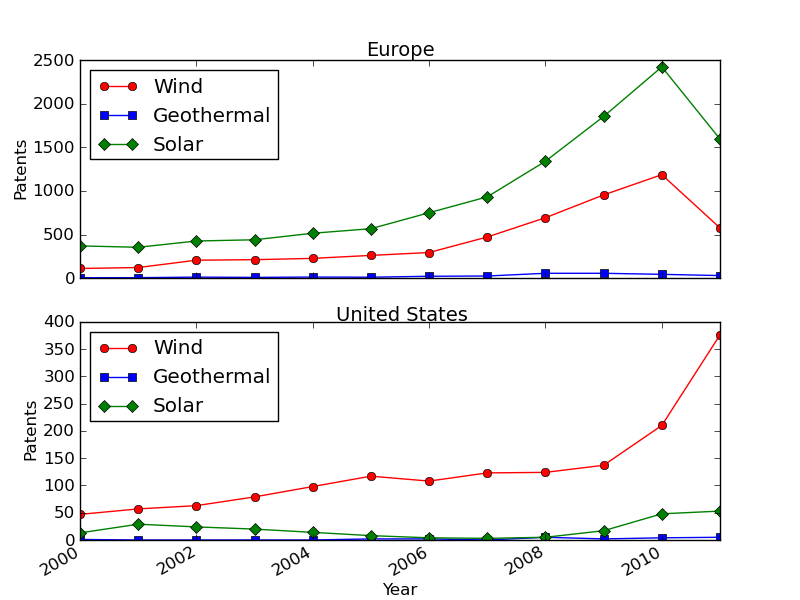Trends in renewable energy R&D: evidence from patent databases
For new renewable energy sources to become competitive with existing generator technology, substantial technological development will be necessary. Marginal costs of electrical generation for wind, solar, and geothermal energy may be very low, but startup costs remain high. What is the state of research and development in these technologies?
To understand trends in technological development, it's helpful to have metrics for the rate at which new innovations are being produced. One intuitive way to do this is with patent data; a patent represents a successful new invention, and therefore the volume of patents relating to a given technology is a reasonable proxy for research outcomes. While the use of patent data is subject to some caveats (e.g., not every patent represents the same amount of innovation and some patents may never actually be used in production), patents do provide an intuitive and comprehensive quantitative metric for the volume of new technology being developed. This strategy has been widely used in recent academic literature.
Data on patents is publicly available through several patent agencies, including the USPTO (which handles patents filed in the United States) and the EPO (which handles patents filed in Europe, including Turkey, Switzerland, and several other non-EU countries). As the United States and Europe are the most active regions for technological innovation, considering these patent offices should give some indication of worldwide research activity in new renewable energy technology. The patent classifications corresponding to wind, geothermal, and solar technology were taken from Popp et al. (2011). Here are the trends in wind, geothermal, and solar energy innovation at these two patent offices:

-
In Europe, wind and especially solar energy have seen rapid growth in technological innovation over the past decade. However, technological growth has slowed sharply as the eurozone budget crisis has forced massive cutbacks in government research funding, particularly in former big spenders Italy and Spain.
-
Wind energy research in the United States has seen steady growth since 2000 with rapidly accelerating growth in recent years. Unlike Europe, there has been limited innovation in solar energy.
-
Patenting activity in geothermal energy is lagging badly compared to the other two energy sources; this is almost certainly a sign of limited technological development. (Alternately, the patents on geothermal technology might represent more significant innovation than the average patent on wind or solar technology – but the patent titles don't present much support for this.)
These innovations are reflected in recent renewable energy installations. According to last week's Pew Charitable Trust report “Who's Winning the Clean Energy Race?”, investment in renewable energy generation has increased sharply in the past five years, both in developed countries like Italy, Germany, and the United States an also rapidly industrializing countries like India, China, and Indonesia.
The dramatic increase in patent activity in recent years signals a rate of technological development that will integral to developing cost-effective renewable energy technology. Hopefully, this process will continue even as governments reduce research funding.
(Image source: detail of solar panel from Max Braun's photostream on flickr. Licensed via Creative Commons.)
